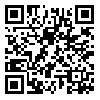Volume 27, Issue 2 (5-2019)
JSSU 2019, 27(2): 1202-1215 |
Back to browse issues page
Farzaneh Barakat 

 , Fatemeh Aboee-Mehrizi
, Fatemeh Aboee-Mehrizi 

 , Bibi Fatemeh Haghiralsadat
, Bibi Fatemeh Haghiralsadat 

 , Mahmood Dehghani Ashkezari *
, Mahmood Dehghani Ashkezari * 




 , Fatemeh Aboee-Mehrizi
, Fatemeh Aboee-Mehrizi 

 , Bibi Fatemeh Haghiralsadat
, Bibi Fatemeh Haghiralsadat 

 , Mahmood Dehghani Ashkezari *
, Mahmood Dehghani Ashkezari * 


Abstract: (3329 Views)
Introduction: Studies have shown that plant compounds have significant anticancer effects that if the challenges of using them are resolved, Can be the successor to the synthetic compounds commonly used in cancer therapy. Therefore, in this study, the liposomal nano- carriers containing Nepeta persica extract have been investigated in order to improve the physicochemical characteristics and evaluation of its antitumor properties.
Methods: The present study is a kind experimental study. Liposomal vesicles were prepared using SPC, cholesterol and PEG by thin-film method and the Nepeta persica extract was loaded into the liposomes. Their physicochemical characteristics were evaluated using Zeta Sizer, FTIR, SEM, and the release pattern of the extract was calculated at 37 oC and 42 oC. At the end, the toxicity of this nano-carriers containing the extract on the MCF-7 cell line of breast cancer has been studied.
Results: The results of the study showed that the nano-carriers containing the extract had an encapsulation efficiency of 67/11±5/74%, size of 116/9 nm, and -13.24 ± 1.01mV zeta potential, spherical morphology and controlled release. Also, the results of the toxicity of this nano-carrier containing the extract indicate that the liposomal extract has a higher toxicity to the MCF-7 cell line than the free extract.
Conclusion: The results of this study show that nano-liposomes containing Nepeta persica extract, mean while having appropriate physiochemical properties, reduce the survival of breast cancer cells compared to non-liposomal extracts, and thus can be a good carriers for delivery of Nepeta persica extract to breast cancer cell.
Methods: The present study is a kind experimental study. Liposomal vesicles were prepared using SPC, cholesterol and PEG by thin-film method and the Nepeta persica extract was loaded into the liposomes. Their physicochemical characteristics were evaluated using Zeta Sizer, FTIR, SEM, and the release pattern of the extract was calculated at 37 oC and 42 oC. At the end, the toxicity of this nano-carriers containing the extract on the MCF-7 cell line of breast cancer has been studied.
Results: The results of the study showed that the nano-carriers containing the extract had an encapsulation efficiency of 67/11±5/74%, size of 116/9 nm, and -13.24 ± 1.01mV zeta potential, spherical morphology and controlled release. Also, the results of the toxicity of this nano-carrier containing the extract indicate that the liposomal extract has a higher toxicity to the MCF-7 cell line than the free extract.
Conclusion: The results of this study show that nano-liposomes containing Nepeta persica extract, mean while having appropriate physiochemical properties, reduce the survival of breast cancer cells compared to non-liposomal extracts, and thus can be a good carriers for delivery of Nepeta persica extract to breast cancer cell.
Type of Study: Original article |
Subject:
Biology
Received: 2018/06/16 | Accepted: 2018/11/17 | Published: 2019/06/3
Received: 2018/06/16 | Accepted: 2018/11/17 | Published: 2019/06/3
| Rights and permissions | |
 |
This work is licensed under a Creative Commons Attribution-NonCommercial 4.0 International License. |

